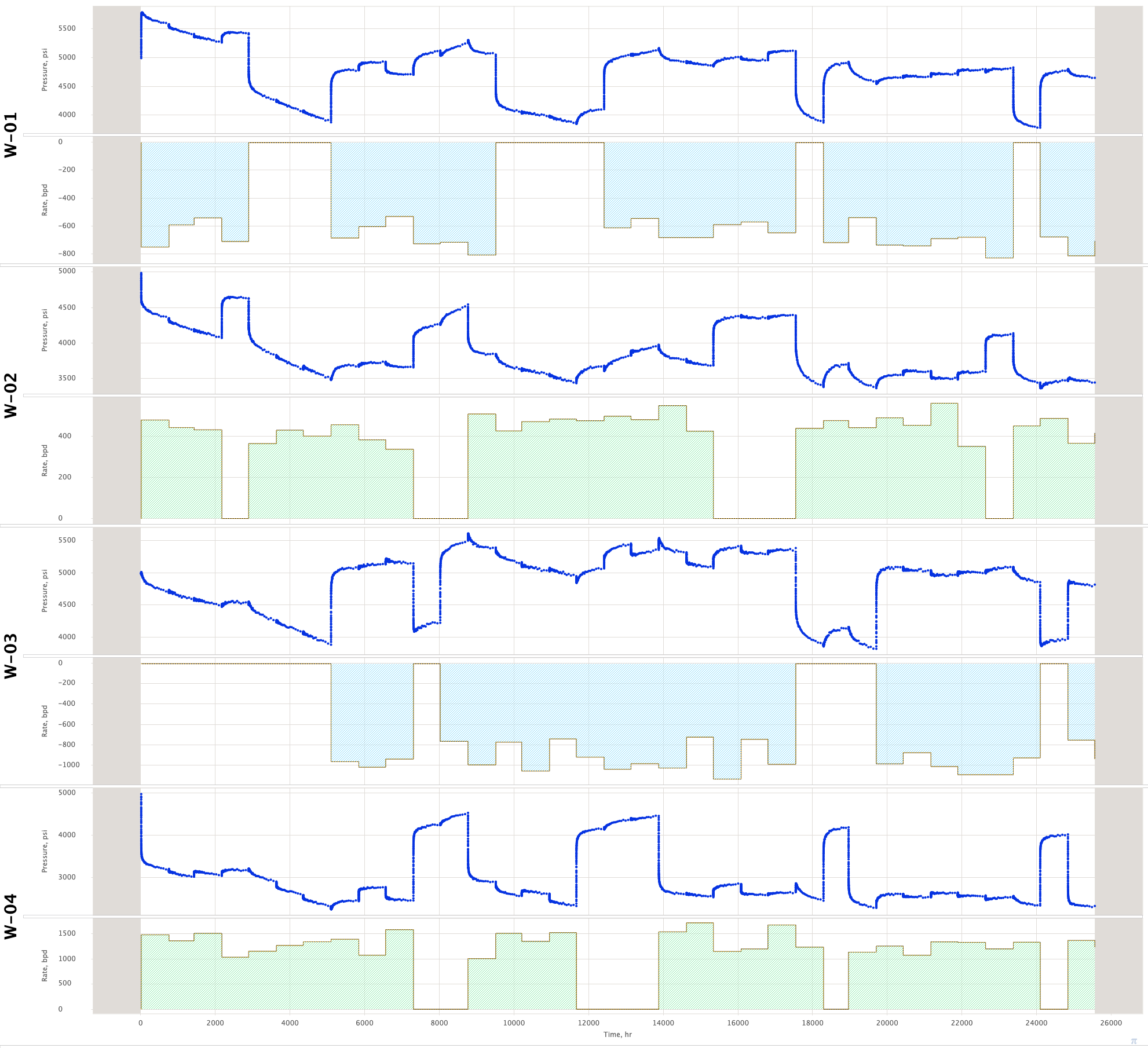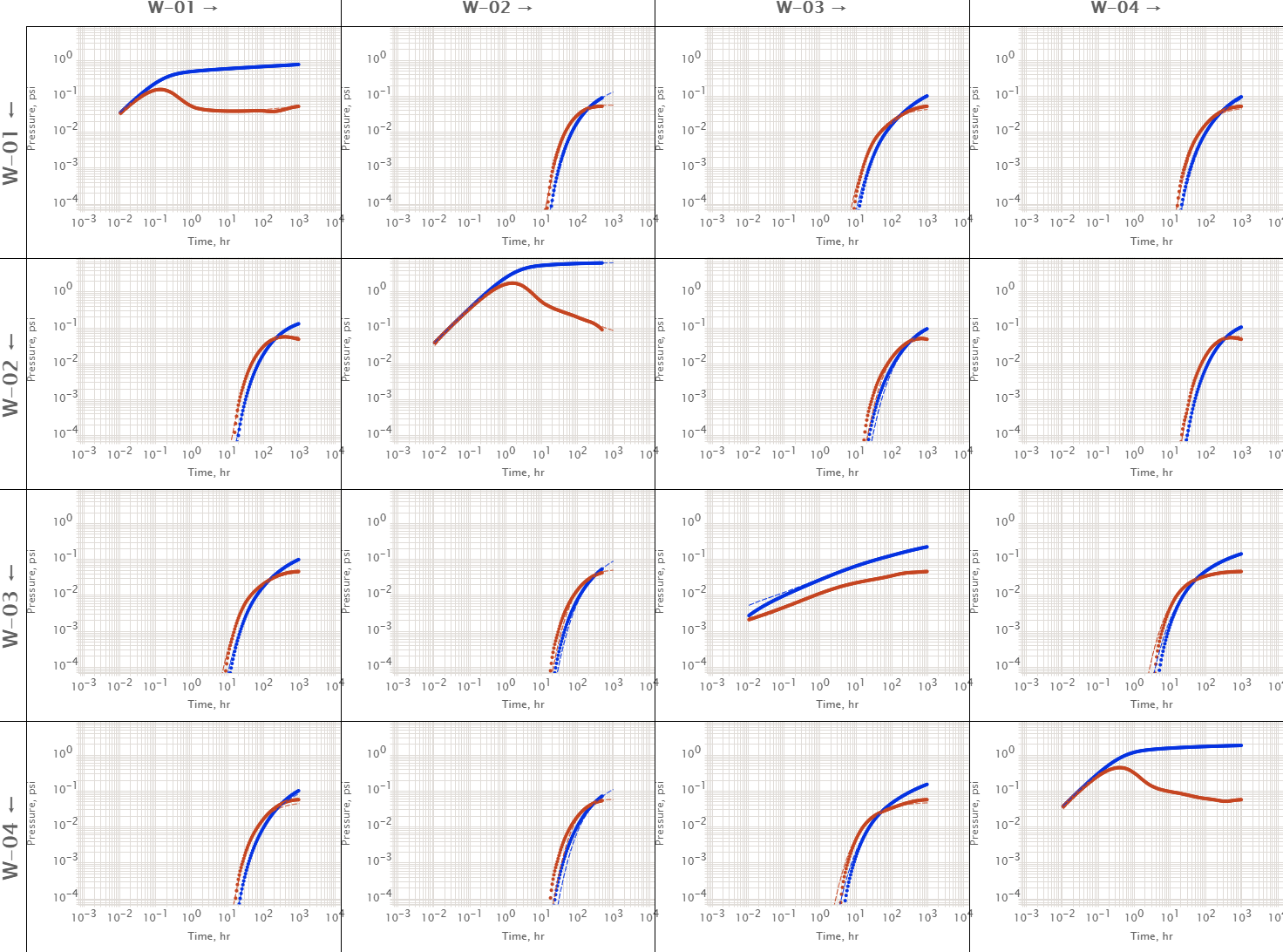| Excerpt | ||||||||||||||||||||||||||||||||||||||||||||||||
|---|---|---|---|---|---|---|---|---|---|---|---|---|---|---|---|---|---|---|---|---|---|---|---|---|---|---|---|---|---|---|---|---|---|---|---|---|---|---|---|---|---|---|---|---|---|---|---|---|
Inverse problem to pressure convolution, performed as a fully or semi-automated search for initial pressure for every well and Unit-rate Transient Responses (UTR) for wells and cross-well intervals in order to fit the sandface pressure response (usually recalculated from PDG data using wellbore flow model for depth adjustment) to total sandface flow rate variation history (usually recalculated from daily allocations based on surface well tests, see Fig. 1).
The basic element of deconvolution is the Unit-rate Transient Response (UTR) which is a sandface pressure response to the total sandface unit-rate production (see Fig. 2).
Multiwell deconvolution (MDCV) specifies two types of UTR: Drawdown Transient Response (DTR) and Cross-well Transient Response (CTR). The Drawdown Transient Response (DTR) is the imaginary sandface pressure response of a given well to its total sandface unit-rate production under condition that no other well is producing/injecting. It is equivalent to conventional Drawdown Test with sandface unit-rate production as if the well is not interfering with surrounding wells. The Cross-well Transient Response (CTR) is the sandface pressure response of a given well to the total sandface unit-rate production of the offset well under condition that no other well is producing/injecting. Although the UTR may last the infinite time but in reservoir engineering practise the UTR is usually assumed to be captured when it develops a boundary-dominated Late Time Response (LTR). It should be noted that sometimes the duration of production history is too short to sense the geometrical boundary and UTR will not capture it in full or not see a boundary at all. The true UTRs are also difficult to acquire in practise as most wells are noticeably interferring during at long-term scales. The exception is the remote well or the well draining an isolated compartment. This defines the application of MDCV which pretends to decipher the UTR from BHP and Production/Injection History. The pressure convolution principle itself has some limitations and may not be adequate for some practical cases. For example, changing reservoir conditions, high compressibility – everything which breaks linearity of diffusion equations. There are some workarounds on these cases but the best practice is to check the validity of pressure convolution (and therefore the applicability of MDCV) on the simple synthetic 2-well Dynamic Flow Model (DFM) with the typical for the given case reservoir-fluid-production conditions. MDCV can be performed in two options: Radial Deconvolution (RDCV) and Cross-well Deconvolution (XDCV). Radial Deconvolution (RDCV) correlates pressure and rate in selected well (called pressure-tested well) and only account for the rates in surrounding wells (called rate-tested wells) in order to reconstruct:
A group of
Only rates are taken into account for offset wells in RDCV. In case a group of tested wells have mulitple pressue gauge installations one may wish to deconvolve the unit-rate transient responses using all of the pressure data which is called Cross-well Deconvolution (XDCV). The main advantage of XDCV over RDCV is the ability to simulate and interpret all PDG simultaneously, resulting in more information and better constrain and stability of deconvolution process. The group of
The intervals between two wells with pressure gauge installations results in two transient response: first well onto the second well and revers. This may indicate anisotropy of pressure propagation in counter directions and shed the light on the resevroir physics between these wells. Once all possible DTR/CTR are deconvolved one can perform a conventional type-curve analysis for each well, defining the type and distance to the boundary, estimating skin, transmissibility and diffusivity around each well. Unlike routine numericial fitting, where
Main benefits of MDCV are:
Main disadvantages of MDCV are:
|
...
Petroleum Industry / Upstream / Subsurface E&P Disciplines / Production Analysis (PA) / Pressure Deconvolution
[ MDCV @model ]
[ RDCV ][ RDCV @model ][ RDCV @sample ]
[ XDCV ][ XDCV @model ][ XDCV @sample ]
[ Multiwell Retrospective Testing (MRT) ]
...

